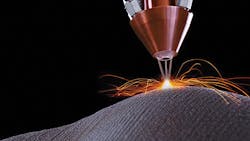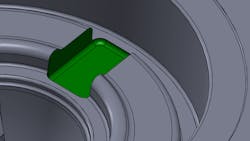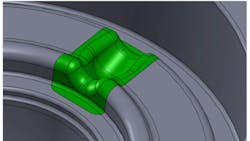Bringing New Life To Old Tools With Additive Manufacturing
The popular understanding of 3-D printing—and the one that always seems to get the most fanfare—is focused on using plastics for modeling and rapid prototyping. But, additive manufacturing techniques with more direct industrial applications, using metals powders and alloys to produce component parts, have been growing increasingly sophisticated in labs and factories during the past decade. It’s a quiet but ongoing mission to bring new tools to the tooling industry, and that mission just got a boost.
In March, the National Additive Manufacturing Innovation Institute (NAMII) announced its first round of award funding: $4.5 million allotted to seven additive manufacturing projects around the country to develop novel solutions and new applications of 3-D printing techniques.
One of those projects, “Qualification of Additive Manufacturing Processes and Procedures for Repurposing or Rejuvenation of Tooling,” awarded to Case Western Reserve University, addresses the tooling industry specifically.
“Our project will focus on the applying additive manufacturing techniques directly to tools and dies to help extend their life and even repurpose them for new uses,” explained James McGuffin-Cawley, chairman of the material science and engineering department at CWRU.
“This is an area that has had a lot of attention and there are a lot of clever people who have done a lot of clever things with it through the decades,” he said. “But there is a special opportunity to use these manufacturing techniques in concert with the repair and repurposing process.”
In fact, there are quite a few special opportunities available through those techniques and there are also some significant financial benefits to be wrought as well. Once these techniques are worked out, McGuffin-Cawley explained, they would have the immediate potential to save millions in retooling costs for foundries, diecasters, and manufacturers across the industry.
“These are large, massive, high-strength tools, many of which cost over $1 million to produce, that are repeatedly used for thousands or hundreds of thousands of cycles,” he said. “Repairing damage and repurposing tools rather than producing a whole new tool would be extremely cost-effective.”
Rejuvenation and repurposing
“I’m very sensitive and very much aware of the tooling and die life and how critical die life is in diecasting,” said David Schwam, research associate professor at Case and lead researcher on the project. “Tooling in so many industries is the key part of the process, and an expensive part of the process. If we can extend die life, extend tool life by the additive manufacturing methods, that could benefit a very wide range of industries.”
This part of the project—the rejuvenation side—will use 3-D scanning to inspect and map cracks, breaks and other wear-related damage to create a CAD design of custom patches to be applied to problem areas.
T“Having this capability of exceeding die life is something that any toolmaker and any diecaster will be very interested in,” Schwam noted. “And it’s broader even than that. Anybody who is using tooling will be very interested in this capability.”
The other side of the project—repurposing—will deliver new techniques that will transform old or obsolete tools and dies into new configurations for different jobs and processes.
“Designs can sometimes be changed when the tool still has life in it,” Schwam explained. “It doesn’t have to be changed that much—it can be, for instance, a dashboard in a new model year of a car that suddenly needs a USB port or something like that. But, that little change requires that you make a totally new die for it, and that can be very expensive.”
With the technique his team will be developing with the NAMII award, diecasters will be able to add material directly to the changed area and then machine it to fit. And with that, the million-dollar die that otherwise would be trash is given a new life.
“That’s the beauty of additive manufacturing,” he said. “You can add material in just the right place, exactly how you need it, and then utilize an existing die with some small change instead of throwing it out.”
What is NAMII?
These refurbishing and rejuvenation projects, and all the benefits they promise, were made possible by NAMII, announced in November 2012 by President Obama. NAMII is the proof-of-concept pilot program for what eventually could be 15 innovation centers funded through the Network for Manufacturing Innovation (NNMI), dedicated to developing advanced manufacturing technologies in the U.S.
The NNMI program depends on a system of collaborative R&D among clusters of universities, manufacturers and government agencies in a public/private funding arrangement.
To help Schwam’s project take hold, the NAMII award pulls together the minds, talents and resources of a weighty group of collaborators, including the NADCA, Twin City Diecasting, General Diecasting, and MAGMA Foundry Technologies Inc., just to name a few. In total, this all-star ensemble has put up $5 million for the project, exceeding even the hefty $4.5 million in government funds from NAMII.
That investment, noted Schwam, should see a very quick return. “Within a year or two, we should have some results from production,” he said. “And that’s not just from the lab. We should have some feedback from diecasters that have real tools put back into production. By then, we’ll really be able to see how much longer they run after we refurbish or repurpose them.”
Those results, he added, may be better than he expected.
“I put in the proposal a relatively modest goal of 20% increase in tool life. But, that is just my sense of not promising more than I’m sure we can deliver,” he said. “I absolutely believe that we can do even better than that.”


